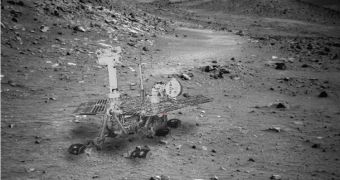Scientists with the NASA Jet Propulsion Laboratory in Pasadena, California, say that hopes of getting the Mars Exploration Rover (MER) Spirit back online are starting to dwindle. The Martian spring is in full swing, and yet no radio signals have been heard from the machine.
An important threshold was reached last week, when the location at which the rover has been trapped since May 2009 received its maximum amount of solar energy for the current Martian year.
Despite this, the vehicle remained silent, despite experts' efforts to contact it on a wide range of frequencies. Even orbiters high up in the Red Planet's atmosphere were used in these attempts.
JPL scientists have been involved in this effort for a few months now. However, all their actions started from the assumption that the last winter did not affect Spirit beyond the point of recovery.
Hopes were high that the rover itself was not damaged, and that – once enough sunshine was available at its location – it would resurrect once more. However, that didn't happen, and the JPL team is beginning to doubt it ever will.
A decision on the robotic explorer's fate has already been made. JPL mission controllers will continue with their efforts for 30 to 60 days more. If, by that time, they hear no signal from Spirit, then they will officially conclude its 7-year mission on Mars.
At that time, the JPL team will also shift to single-rover operations, centered on Opportunity. The other MER robot is happily trotting along on the other side of Mars, heading for its long-term target, the Endeavor Crater.
“The commands we are sending [to Spirit] starting this week should work in a multiple-fault scenario where Spirit's main transmitter is no longer working and the mission clock has lost track of time or drifted significantly,” explains JPL MER project manager, John Callas.
The last time the robot made contact with JPL was shortly before the Martian winter set in at its location, on March 22, 2010. Since then, scientists have had no success in getting the machine to respond to hails sent out on multiple frequencies.
Regardless of its ultimate fate, the fact remains that the machine landed on Mars on January 4, 2004, for a six-month mission. It exceeded its allotted survival time at least 20 times over.
“During the Martian winter with most heaters turned off, Spirit experienced colder internal temperatures than in any of its three previous winters on Mars,” JPL experts say.
“The cold could have damaged any of several electronic components that, if damaged, would prevent reestablishing communication with Spirit,” they conclude.

 14 DAY TRIAL //
14 DAY TRIAL //